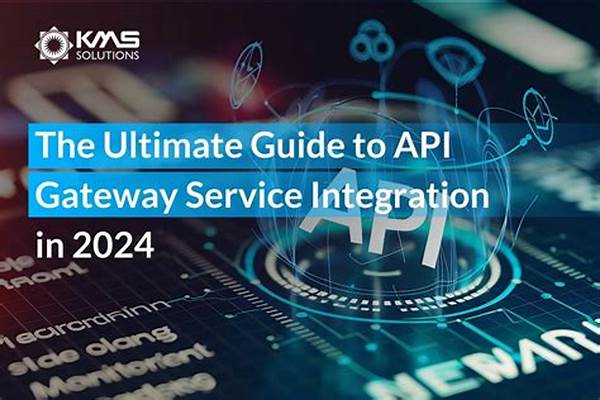API integration has become a cornerstone in today’s digital infrastructure, providing an essential bridge between disparate systems and fostering seamless data exchange. However, as businesses expand and technological demands escalate, the challenges in scalable API integration become increasingly pronounced. These challenges necessitate solutions that can withstand rapid growth without sacrificing performance or reliability.
Read Now : Scalable Data Integration Tools Comparison
Overcoming Latency Issues
Latency remains one of the primary challenges in scalable API integration. As the number of connected applications increases, the potential for latency exponentially grows, hindering the seamless flow of data. Reducing latency involves optimizing network protocols and infrastructure, as well as carefully managing API requests and responses. Techniques such as caching, load balancing, and asynchronous processing can mitigate these latency issues, ensuring that systems remain responsive and efficient.
Security also emerges as a critical concern in the realm of scalable API integration. With each additional API connection, the attack surface expands, heightening the risk of security breaches and unauthorized access. Employing robust authentication methods, secure data encryption, and regular security audits can mitigate these vulnerabilities. Moreover, adopting industry-standard security practices, such as OAuth and token-based authentication, can help safeguard sensitive information and maintain the integrity of integrated systems.
Scalability itself presents its own set of challenges in API integration. As businesses grow, the API infrastructure must adapt to handle increasing loads without degradation of service. Ensuring scalability often requires investment in cloud-based solutions and microservices architectures, which offer greater flexibility and scalability. This shift not only coordinates resource allocation more effectively but also enhances system resilience against unexpected traffic spikes.
Ensuring Data Consistency
Data consistency is another critical challenge in scalable API integration. As APIs become more widespread and interconnected, ensuring data integrity across platforms becomes crucial. Inconsistencies in data exchange can lead to operational disparities and analytical inaccuracies, undermining business decisions. Managing these challenges in scalable API integration requires the implementation of comprehensive data validation and synchronization techniques.
Managing API Versioning
1. API versioning introduces challenges in scalable api integration, as managing multiple versions can lead to increased complexity and potential for error.
2. Regular updates and backward compatibility are imperative to mitigate disruptions in service.
3. Effective version management practices reduce friction and encourage seamless integration.
4. Clear communication with stakeholders about version changes is essential for maintaining service reliability.
5. Employing robust documentation ensures transparency and aids in managing versions efficiently.
Enhancing System Reliability
System reliability is paramount when addressing the challenges in scalable API integration. As systems expand and demand increases, maintaining consistent reliability becomes arduous. Implementing redundant systems and failover mechanisms enhances system reliability and mitigates potential downtime. Furthermore, employing systematic monitoring and logging can pre-emptively identify and resolve issues before they escalate into significant disruptions.
Empowering systems with elastic scaling capabilities also contributes significantly to reliability. By dynamically adapting to fluctuating demands, systems prevent overloads and ensure continuous operation without interruption. Additionally, adopting a microservices architecture allows for isolation of failures and promotes system resiliency, minimizing the impact of disruptions on the broader ecosystem.
Cloud-based solutions offer another layer of reliability enhancement. Utilizing cloud environments provides access to scalable resources and disaster recovery solutions, fortifying systems against unexpected failures. This adaptive infrastructure supports rapid recovery and continuity of service, enabling businesses to navigate the challenges in scalable API integration with resilience and agility.
Addressing Deployment Complexities
Deployment complexities often compound challenges in scalable API integration. Coordinating frequent updates across diverse platforms and environments amplifies the risk of deployment failures and service instability. Automation tools, such as CI/CD pipelines, can streamline deployment processes and reduce manual intervention, thereby minimizing error margins and ensuring consistency in deployments.
Read Now : Efficient Api Load Balancing
Thorough testing prior to deployment is crucial to circumvent potential pitfalls. Rigorous testing frameworks identify integration vulnerabilities and rectifies them preemptively, ensuring seamless deployment experiences. Adaptive deployment strategies, such as blue-green and canary deployments, further mitigate deployment risks by minimizing exposure and allowing for rapid rollback if issues arise.
In conclusion, addressing the challenges in scalable API integration necessitates a multifaceted approach that encompasses latency reduction, data consistency, system reliability, and deployment efficiency. Through the adoption of automated tools, robust security protocols, and adaptive scaling techniques, businesses can effectively manage the complexities inherent in API integration and foster resilient digital ecosystems.
Future Trends in API Integration
As the digital landscape evolves, new trends emerge that shape the future of API integration. Anticipating these changes is crucial in addressing the challenges in scalable API integration.
1. The rise of artificial intelligence and machine learning-powered APIs facilitates more dynamic and responsive integrations.
2. Increased focus on event-driven architectures enhances real-time data exchange, minimizing latency.
3. The growth of IoT necessitates more intricate integrations, expanding the scope of challenges in API scalability.
4. Adoption of decentralized technologies like blockchain could offer more secure and transparent integration solutions.
5. The emphasis on improved developer experience streamlines the integration process, reducing integration friction.
Conclusion and Long-term Strategy
In navigating the challenges in scalable API integration, organizations must adopt a long-term strategic outlook. Continuous innovation, combined with proactive maintenance of API ecosystems, ensures adaptability and resilience against future challenges. Establishing clear integration protocols and fostering a collaborative mindset across teams is paramount.
The evolution of technology necessitates agile responses to integration demands. Investing in continued education and skill development for API administrators can bolster integration capabilities. Forward-thinking strategies that incorporate new communication protocols and technologies guarantee sustained scalability, efficiency, and competitive advantage in an increasingly interconnected world.
